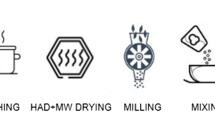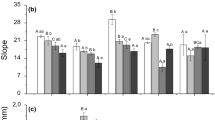Abstract
Energy bar sample were prepared with different levels of flaxseed (0–20%) in addition to cereals and pulses with varying levels of sweeteners (45, 50, and 55%) to deliver a nutritious food to the consumer. The developed bars were evaluated for textural, colour, nutritional quality, sensory attributes and total microbial load. Different levels of flaxseed and sweeteners significantly affected the hue and chroma values of the energy bar. In general the level of flaxseed in energy bar did not affect the hardness but it was decreased with increasing level of sweeteners except in control sample. The total calories obtained from the energy bar showed significant increase with the increasing levels of flaxseed, the maximum (397.95 kcal) being for bars with 20% flaxseed and 45% sweeteners. This energy bar sample also showed the maximum protein (12.41%), crude fat (11.86%), ash (1.65%), iron (3.77 mg/100 g), crude fiber (2.18%) and omega-3 as alpha-linolenic acid (22.50%, fatty acid basis) content. The overall mean sensory score for overall acceptability for samples with 10% flaxseed and 55% sweeteners and 15% flaxseed and 45% sweeteners were at par but the omega-3 and other nutrients in the later sample was higher than the former sample, hence, 15% flaxseed and 45% sweeteners along with other ingredients may be considered for production of acceptable quality omega-3 fatty acid rich energy bar at commercial scale, which also stored well at refrigerated condition.

Similar content being viewed by others
References
Anonymous (1994) Flaxseed has potential in human nutrition. J Am Diet Assoc 94:42
AOAC (2000) Official methods of analysis, 17th edn. Association of Official Analytical Chemists, Washington DC
Appleqvist LA (1968) Rapid methods of lipid extraction and fatty acid esters preparation for seed and leaf tissue with special remarks on preventing the accumulation of lipid contaminants. Ark Kenci 28:351–70
Barnwal P, Singh KK, Mridula D, Kumar R, Rehal J (2010) Effect of moisture content and residence time on dehulling of flaxseed. J Food Sci Technol 47(6):662–667
Bhaskaran S, Hardley F (2002) Buyer beliefs, attitudes and behaviour: foods with therapeutic claims. Journal of Consumer Marketing 19:591–606
Bhathena SJ, Ali AA, Mohamed AI, Hansen CT, Velasquez T (2002) Differential effects of dietary flaxseed protein and soy protein on plasma triglyceride and uric acid levels in animal models. J Nutr Biochem 13:684–689
BIS (1971) IS: 6273 Part I and Part II—1971. Guide for sensory evaluation of foods. Indian Standard Institution, Manak Bhawan
Bourne MC (1978) Texture profile analysis. Food Technology 32:62–66
Burn D (2007) On the rise. Food in Canada 67(1):28–32
Cruickshank R, Duguid JP, Marmion BP, Swain RHA (1975) Medical microbiology—the practice of medical microbiology. Churchill Livingstone, Edinburgh
Deshpande S, Bargale PC, Joshi KC, Singh V, Varghese S (2004) Enhancing the nutritive value of barley based sattu by soy-fortification. Ind J Nutr Dietet 41(4):146–159
Gray J, Armstrong G, Farley H (2003) Opportunities and constrains in the functional food market. Nutrition and Food Science 33:213–218
Lucas EA, Wild RD, Hammond LJ (2002) Flaxseed improves lipid profile without altering biomarkers of bone metabolism in postmenopausal women. J Clin Endocrinol Metab 87:1527–1532
Mridula D, Rita J, Singh KK (2010) Effect of storage on quality of fortified bengal gram sattu. J Food Sci Technol 47(1):119–123
Nagaraj G (2009) Oilseeds-properties, processing, products and procedures. New India Publishing Agency, New Delhi
Oomah BD, Mazza G (1998) Fractionation of flaxseed with a batch dehuller. Ind Crops Prod 9:19–27
Ramcharitar A, Badrie N, Mattfeldt-Beman M, Matsuo H, Ridlet C (2005) Consumers acceptance of muffins with flaxseed (Linum usitatissimum). J Food Sci 70:504–507
Sahu A, Vajpeyi M, Mohan M (2009) Detoxification of linseed (Linum usitatissimum L.) meal for enrichment of wheat flour chapati. J Food Sci Technol 46:470–472
Shen H, He L, Price RL, Femandez MI (1998) Dietary soluble fibers lowers Plasma LDL cholesterol concentrations by altering lipoprotein metabolism in female guinea pigs. J Nutr 128(9):1434–1441
Sloan AE (2005) Top 10 global food trends. Food Technology 59:20–32
Sowbhagya CM, Bhattacharya KR (1976) Lipid autoxidation in rice. J Food Sci 41:1018–1023
Sujatha T, Narahari D (2010) Effect of designer diets on egg yolk composition of ‘White Leghorn’ hens. J Food Sci Technol. doi:10.1007/s13197-010-0132-z
Tarpila A, Wennberg T, Tarpila S (2005) Flaxseed as a functional food. Current Topics in Nutraceutical Research 3(3):167–188
Thakur BR, Arya SS (1990) Packaging requirements and stability of fried wheat snacks (Trisnacks). J Food Sci Technol 27(2):76–81
Thapar VK, Sehgal VK, Shashi P (1988) Post harvest quality analysis of foodgrains—research bulletin. Department of Processing and Agricultural Structures, Punjab Agricultural University, Ludhiana, pp 13–14
Zhang W, Xu S, Wang Z, Yang R, Lu R (2009) Demucilaging and dehulling flaxseed with a wet process. LWT Food Sci Technol 42:1193–1198
Acknowledgement
Authors express sincere thanks to DST, New Delhi for financial assistance and Director, CIPHET for providing facilities for conducting this study.
Author information
Authors and Affiliations
Corresponding author
Rights and permissions
About this article
Cite this article
Mridula, D., Singh, K.K. & Barnwal, P. Development of omega-3 rich energy bar with flaxseed. J Food Sci Technol 50, 950–957 (2013). https://doi.org/10.1007/s13197-011-0425-x
Revised:
Accepted:
Published:
Issue Date:
DOI: https://doi.org/10.1007/s13197-011-0425-x




